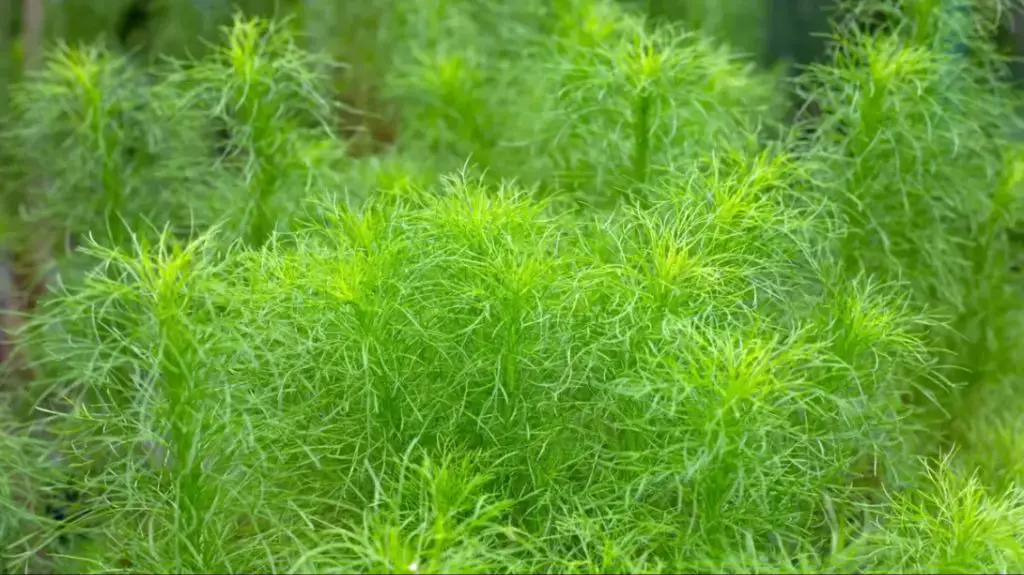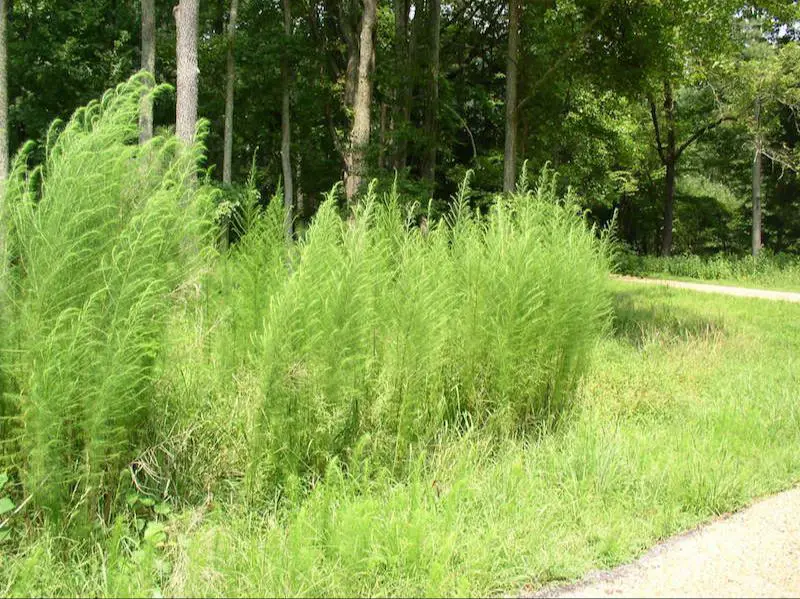What is Dog Fennel?
Dog fennel (Eupatorium capillifolium) is a herbaceous perennial plant in the aster family that is native to the eastern and southern United States. It is also known by several other common names including eastern dog fennel, dogfennel, eupatorium, and wild fennel. The plant has finely divided green leaves similar to cultivated fennel, which gives rise to its name. Dog fennel thrives in poor soils and readily colonizes roadsides, fields, forest edges, and other open areas.
Is Dog Fennel Toxic or Poisonous?
Dog fennel contains active chemical compounds that can cause toxicity issues for some people and animals. The most concerning compounds are thujone and fenchone.
Thujone is known to be toxic to the brain and liver if consumed in high amounts. Ingesting dog fennel can cause neurological issues like seizures. Thujone also has hallucinogenic properties. However, touching dog fennel plants is not likely to cause thujone poisoning, as this requires consuming it.
Fenchone is a chemical that can irritate mucous membranes and skin. Contact with fenchone may cause dermatitis, especially in people with sensitivities. It is also toxic to cats and dogs if ingested. Cattle have been poisoned from eating high amounts of dog fennel.
While dog fennel contains concerning compounds, touching the plant is not normally dangerous for humans. Brief contact does not transfer enough thujone or fenchone to cause toxicity issues. Still, skin irritation is possible, so precautions should be taken.
Skin Irritation and Allergic Reactions

Some people may experience skin irritation or allergic reactions from touching dog fennel. The plant contains chemicals called sesquiterpene lactones which can cause contact dermatitis in sensitive individuals.
Allergic reactions are fairly common, with estimates that 15-30% of people being sensitized to plants in the Asteraceae family, which includes dog fennel. Reactions can occur upon first exposure or may develop over time with repeated contact.
Typical symptoms include redness, itching, swelling, rash, and blistering where the plant touched the skin. The rash usually develops within 24-48 hours. In severe cases, the reaction can spread beyond the initial contact area. Some people may also experience respiratory symptoms like runny nose and asthma.
The irritation and allergy symptoms are generally mild. Avoiding further contact with the plant is the main treatment. Topical steroids, oral antihistamines, or cool compresses can help relieve discomfort. Seek medical attention immediately if you experience a severe reaction with swelling, trouble breathing, or widespread rash.
Safety Precautions for Touching Dog Fennel
When handling dog fennel, it’s wise to take some basic precautions to avoid skin irritation or allergic reactions:
- Wear gloves when touching any part of the dog fennel plant. The oils can cause skin irritation for some people, so gloves form a protective barrier.
- Wash your hands after contact with dog fennel. Thoroughly rinse off any plant oils to prevent residual irritation.
- Avoid touching dog fennel if you know you have allergies to plants in the carrot family. For sensitive individuals, contact can trigger rashes, itching, swelling, or other allergic responses.
Taking these simple precautions allows most people to handle dog fennel safely. However, if you experience strong skin reactions or difficulty breathing after contact, seek medical attention immediately.
Benefits of Dog Fennel

Dog fennel has been used traditionally for various medicinal purposes. Native American tribes utilized the plant to treat digestive issues, fever, coughs, and snakebites. The Seminole tribe specifically used dog fennel for menstrual cramps and as a snakebite antidote.
Modern scientific research has uncovered potential benefits of dog fennel. Extracts from the plant have demonstrated antimicrobial properties in lab studies, showing effectiveness against certain bacteria, fungi, and viruses. Other studies with animal models indicate dog fennel may have anti-inflammatory, analgesic, anticonvulsant, and sedative effects.
Additional research is still needed to fully understand the medicinal benefits of dog fennel for humans. However, the plant shows promise due to its long history of traditional uses and early scientific findings. More studies are required to determine optimal extraction methods, active compounds, safety, and efficacy before dog fennel extracts can be developed into standardized herbal remedies.
When You Should Not Touch Dog Fennel
There are certain situations when it is best to avoid touching dog fennel. If you have sensitive skin or known allergies, direct contact could trigger an irritating reaction. The sap contains chemicals that can cause skin inflammation and rashes in those with heightened sensitivity.
Additionally, you’ll want to refrain from touching dog fennel if the plant appears damaged, discolored, or unhealthy. This could be a sign of a toxicity issue or disease, making it more prone to cause adverse effects. Avoid contact and seek medical care if you experience a reaction.
In general, healthy individuals without sensitivities can likely touch dog fennel briefly without issue. However, it’s wise to wash your hands afterwards and limit extended exposure. Use gloves for prolonged handling and take care to identify the plant correctly. If in doubt, don’t touch unknown plants to be safe.
Proper Identification to Avoid Mix-Ups
Dog fennel has a characteristic appearance that helps distinguish it from other common plants. However, there are some key differences to look for to properly identify it:
Dog fennel has fine, threadlike leaves that are very aromatic when crushed. Similar looking plants like yarrow or wild carrot have thicker, fern-like foliage. Dog fennel’s leaves are also alternate on the stem rather than opposite like yarrow.
The small yellow flowers of dog fennel grow in flat-topped clusters at the top of a single, unbranched stem. Queen Anne’s lace and wild carrot have larger white flowers clustered into an umbel shape.
Unlike many umbellifers, dog fennel lacks a basal rosette of leaves at ground level. Instead, the leaves extend up the entire stem. Dog fennel also has a smoother stem compared to the hairy stems of wild carrot.
So in summary, look for the fine, fragrant foliage arranged alternately up a smooth, single stem culminating in yellow clustered flowers. These unique identifiers will help properly distinguish dog fennel from lookalikes.
Cultivation and Removal Tips
Dog fennel thrives in a variety of conditions, including full sun, partial shade, and even poor soil. It can grow in lawns, gardens, pastures, roadsides, and disturbed areas. The plant spreads aggressively through rhizomatous roots and prolific seed production. Each plant can disperse over 100,000 tiny seeds per season.
To control or remove dog fennel, cutting or mowing the plants is often the first step to stop seed spread. However, the plant will likely regrow from its underground roots unless the roots are fully removed. Digging up the roots can be difficult due to their deep, extensive growth.
Herbicides containing glyphosate or triclopyr can effectively kill dog fennel. Apply them directly to the foliage or use cut-stump treatments for larger plants. Follow-up applications are typically needed. Combining manual removal and herbicide treatments often provides the best control.
For large infestations, repeated mowing or tillage can help exhaust root reserves over time. Burning the dead stems after mowing may also weaken the plant. But chemical applications are usually still required.
Early prevention by removing young plants is ideal before they can spread. Ongoing monitoring and maintenance is required since seeds can persist in the soil for several years. Consistent removal efforts are key to controlling dog fennel.
Uses for Dog Fennel
Dog fennel has a variety of beneficial uses, despite its potential to cause skin irritation. When handled properly, the plant can be used for culinary, medicinal, and pest deterring purposes.

Culinarily, dog fennel shoots, leaves, and yellow flowers can be eaten much like its cultivated relative, the Florence fennel. The fronds and flowers can be used as garnish or added to salads for a light anise-like flavor. Dog fennel is sometimes used to flavor fish, lamb, and veal dishes in place of other herbs.
Medicinally, dog fennel has been used as a digestive aid due to its carminative and antispasmodic properties. Traditionally, it has been used for treating flatulence, nausea, and infant colic. The plant also has mild antimicrobial effects and has been used as a remedy for respiratory infections. However, medicinal claims remain scientifically unproven.
As a natural pest deterrent, dog fennel produces a strong aroma that can repel certain insects, including mosquitoes, ticks, and fleas. The plant may be planted around the periphery of a garden or crushed leaves can be rubbed on the skin as an insect repellent. Dog fennel has also been used historically for deterring snakes, rodents, and mammals from gardens and homes.
Key Takeaways on Touching Dog Fennel

In summary, dog fennel is generally safe to touch briefly. However, prolonged contact can cause skin irritation, rashes, or allergic reactions in some people. It’s best to take precautions like wearing gloves and washing your hands after handling.
It is okay to touch dog fennel if you are just brushing past it, harvesting it for use, or uprooting it for removal. But avoid touching the plant oils and then rubbing your eyes or face, as this can cause irritation. Also avoid ingesting any part of dog fennel, as it can be toxic if eaten.
For proper handling, wear gloves and long sleeves when working with large amounts of dog fennel plants. Wash your hands and skin thoroughly after contact. And take care to correctly identify dog fennel, not mixing it up with poison hemlock and other toxic look-alikes.
By being aware of the risks and taking sensible precautions, most people can safely touch dog fennel with no issues. Just avoid prolonged, repeated contact and ingestion to minimize any skin irritation or health hazards.